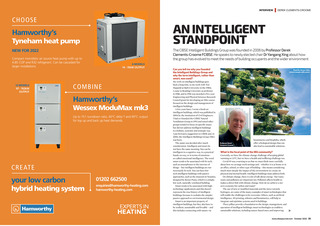


INTERVIEW | DEREK CLEMENTS-CROOME AN INTELLIGENT STANDPOINT The CIBSE Intelligent Buildings Group was founded in 2006 by Professor Derek Clements-Croome FCIBSE. He speaks to newly elected chair Dr Yangang Xing about how the group has evolved to meet the needs of building occupants and the wider environment Can you tell me why you founded the Intelligent Buildings Group and why the term intelligent, rather than smart, was used? My work on intelligent buildings goes back a long time, to my work with Ted Happold at Bath University in the 1980s. I came to Reading University as professor in 1988, and in 1996 was awarded a five-year Engineering and Physical Sciences Research Council grant for developing an MSc course focused on the design and management of intelligent buildings. A few years later, I wrote a book on intelligent buildings, which was published in 2004 by the Institution of Civil Engineers. I had co-founded the CIBSE Natural Ventilation Group in 1992 and noted other groups tended to focus on specific issues but did not address intelligent buildings in a holistic, systemic and strategic way. I put forward a suggestion to CIBSE and, in 2006, the Intelligent Buildings Group (IBG) was born. The name was decided after much consideration. Intelligent and smart do not have the same meaning. You can be intelligent in a cognitive way, in a practical hands-on way, or in terms of emotions so-called emotional intelligence. The word smart tends to be associated with hi-tech, such as smartphones or the internet of things but intelligent buildings are not necessarily hi-tech. You can have lowtech intelligent buildings with passive approaches, such as the museum in Nouma, designed by Renzo Piano, which is a simple, low-tech, naturally ventilated building. Smart tends to be associated with hightechnology applications and this doesnt represent the true history of intelligent buildings, because it excludes the simpler passive approach to environmental design. Smart is an important property of intelligent buildings, but they also have to be resilient, sustainable and liveable and this includes connecting with nature via Biophilic design helps connect people with nature Professor Derek Clements-Croome biomimetics and biophilia, which offer a biological design that can also lead to sustainable solutions. What is the focal point of the IBG community? Currently, we have the climate change challenge of keeping global warming to 1.5C, but we have a health and wellbeing challenge too. Covid-19 was a warning to us that we must think more carefully about how we arrange work settings and whether it is at home or in an office, school, or other type of building this means considering much more deeply the impact of the environment we create on physical and mental health. Intelligent buildings must address both. On climate change, there is a lot of talk about energy but water, waste and pollution are important too. Pollution affects health so makes a direct link with climate change. How do we achieve a net zero economy for carbon and waste? The use of new or modified materials and the move towards hydrogen, are some of the many examples of smart technologies that will enable the challenges to be overcome. Others, such as artificial intelligence, 3D printing, robotics and biomimetics, will help to integrate and optimise systems used in buildings. Three pillars provide a foundation to the design, management, and operation of intelligent buildings: smart technologies as enablers; sustainable solutions, including nature-based ones; and improving www.cibsejournal.com October 2022 35 CIBSE Oct 22 pp35-36 Derek Clement Croombes.indd 35 26/09/2022 17:38